The good folks at Hyundai have scrambled my brain with the 2025 Ioniq 5 N, a devilish little electric compact crossover that might just be a motorsports game-changer.
Most electric vehicles are a blast to drive in a straight line, with incredible acceleration and accessible power. But their weight becomes a liability on the race track, and battery cooling can put a damper on the fun well before running through a charge.
Like many “sporty” versions of best-selling cars—think the Toyota Corolla GR or the Acura Integra Type S—the Ioniq 5 N gets more power, a wider stance, and upgraded tires. The car still has all the tech features we’ve come to expect in a Hyundai like automatic emergency braking, a driver-assistance system that helps ease fatigue on the highway trips, wireless Apple CarPlay and Android Auto, and a large digital gauge cluster and infotainment screen.
However, the company wanted to build an EV that would entice ICE enthusiasts over to the electron world. By and large, enthusiasts don’t care about tech features. Instead, we want emotion. We want to feel connected to the car, like the vehicle is an extension of ourselves. We want to feel joy and excitement and yes, just a touch of fear.
Whoo boy does this thing rock.
2025 Hyundai Ioniq 5 N – Emme Hall
Green Car Reports sent me out to Laguna Seca Raceway with five specific questions—in bold below—to answer. I spent the day amidst professional drivers and Hyundai engineers, dutifully fulfilling my assignment and wondering at the absurdity of hooning a ridiculously powerful car on a compelling track and getting paid for it. Y’all, it was a good day.
Does N Grin Boost put a grin on your face in the Ioniq 5 N? Did you use it on the track?
N Grin Boost is the equivalent to a go-fast gold coin in a video game. Press the red button labeled NGB on the steering wheel and the Ioniq 5 N gives you all 641 horsepower and 568 pound-feet of torque for 10 seconds. Drivers can do this as long as the battery is at a 30% or higher state of charge.
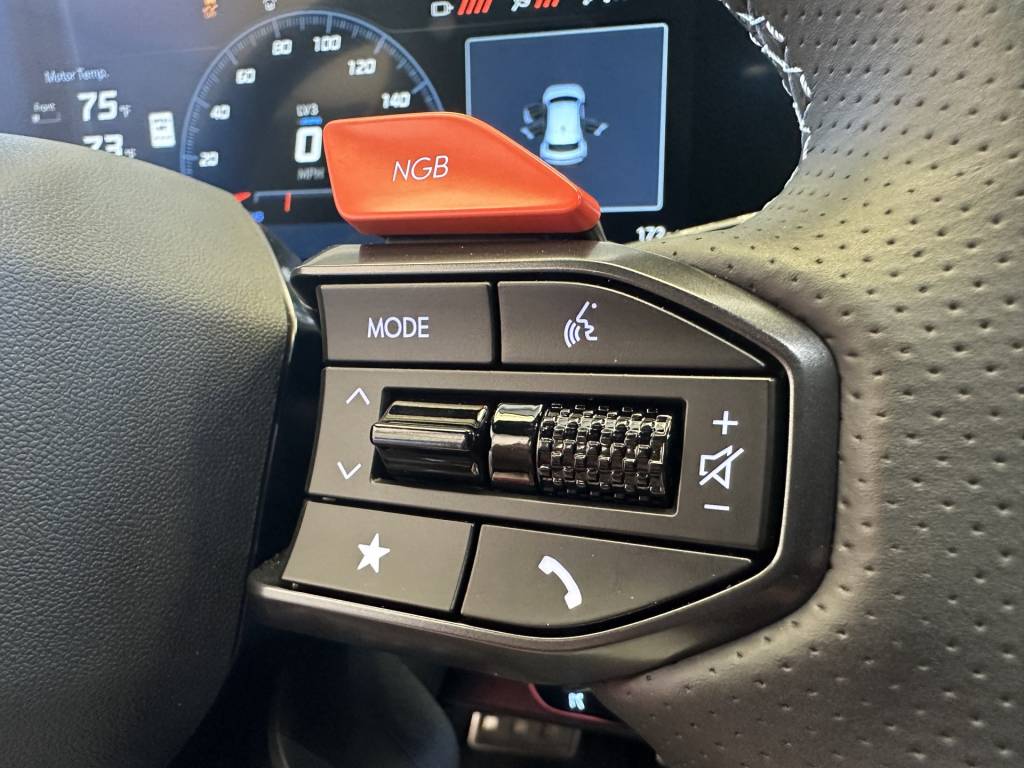
2025 Hyundai Ioniq 5 N – Emme Hall
Laguna Seca Raceway is a complicated track with plenty of blind crests, tricky decreasing-radius turns and a 0.2-mile front straight. This straight, I figured, would be a good place to boost, and thus grin.
I’m not quite sure how fast I was going when I hit the button. I had just finagled my way out of turn 11, a 90-degree left-hand turn, so it couldn’t have been more than 35 or 40 miles per hour. I floored the accelerator, waited a few seconds and smacked my right thumb on that NGB button.
Did I grin? Yes. Did I also panic? Again, yes. I had been using one of Hyundai’s pre-programmed propulsion sounds—more on that in a minute—and as soon as the NGB kicked in, all went silent. It was like I was suddenly in a hyperspace vortex where time and physics meant nothing.
Space, however, was in full effect as I careened towards turn one, a blind crest that turns slightly left that has terrified me every single time I’ve been to this track. I risked a brief glimpse of my speedometer and saw 105 miles per hour.
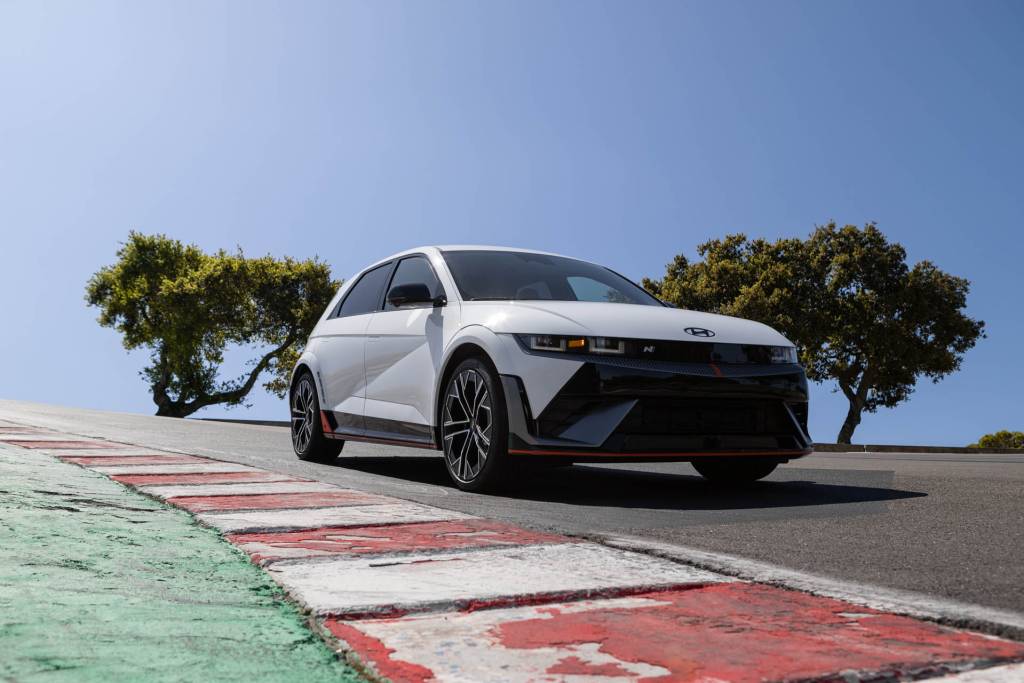
2025 Hyundai Ioniq 5 N
“This is fine,” I thought. “I’m fine, everything is fine.”
I managed to stay in the throttle over the crest without any kind of Code Brown moment, but the hysterical laughter that came out of me served as a reminder that I was indeed experiencing a tiny bit of fear. I got on the brakes hard and somehow managed to get through turn 2, the Andretti Hairpin, before NGB deactivated itself, the fake noises came back on and I was back to a slightly more manageable pace.
Hyundai later told me that NGB can be set to one of three audible sounds and doesn’t have to be silent. In retrospect it was kind of cool for the car to go quiet, as it was very clear something was happening. I just wasn’t necessarily prepared for it.

2025 Hyundai Ioniq 5 N
How do the fake gearshifts work in the Ioniq 5 N? Why did Hyundai choose this and did it ever consider a two-speed gearbox?
The Ioniq 5 N plays games with the driver with a simulated shiftable transmission, while it’s actually just running its motor up the rev range. Sure, I could keep it in Auto mode and let the two electric motors spin all the way up to 21,000 rpm, or I could let the computer in the N e-Shift feature manipulate my emotions a bit, keeping the motor—my perception of the motor—at a maximum of 7,750 rpm and divided into eight steps, making me feel more at one with the car.
Combined with the simulated sounds—and be patient, I’ll get there—shifting the car gave me a much more visceral experience. Auto mode is fine for toddling to the grocery store, but this is Laguna Seca, dammit. I wanted to feel like I was driving the car. I wanted to be in control.
The way the Hyundai engineers developed the simulated shifts is so simple it borders on genius and surely borrows from a driving simulator. When in manual mode, if I use the right paddle to upshift, the torque briefly drops then blips up, all in a nanosecond. From the driver seat it felt at minimum like a gentle push, but when I was on the throttle it was enough to jolt my head back a little, just like a real transmission would do when under load.
Coming into corners I could downshift and get some engine braking to help slow the car down, and put a few electrons back in the 84-kwh battery (more capacity than any other Ioniq 5). For science, I tried exiting turn 11 in fourth gear and the car protested with a noticeable lag, just like it would with an actual manual transmission.
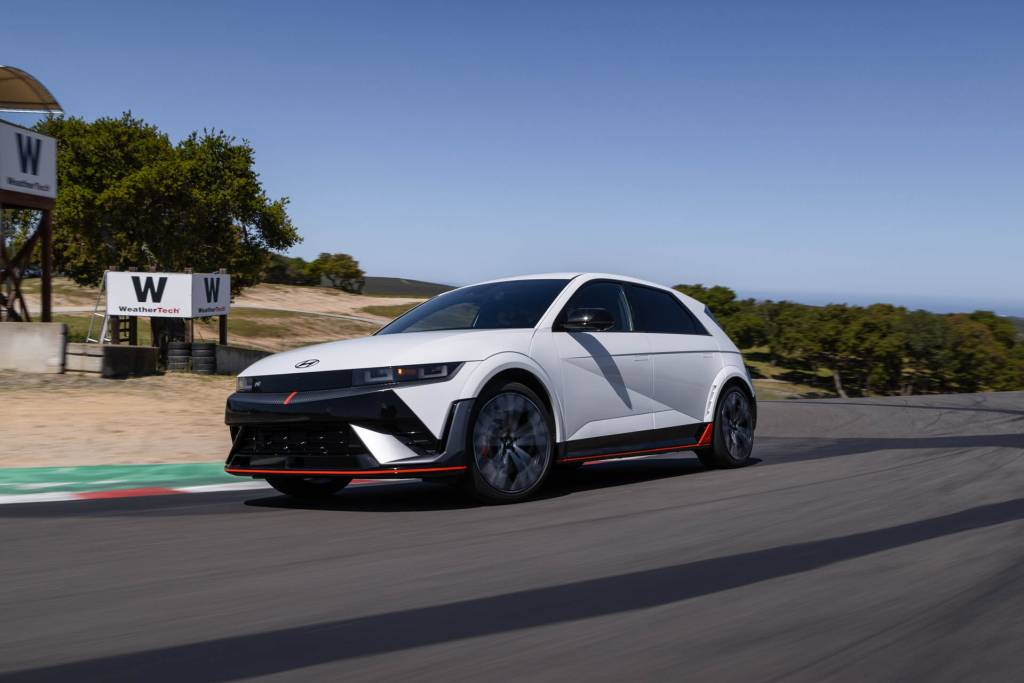
2025 Hyundai Ioniq 5 N
Hyundai could have gone the Porsche Taycan route and opted for a two-speed transmission, but again, it’s looking to build a bridge for ICE enthusiasts to cross over to The Democratic Republic of EVs. The company knows enthusiasts like manual transmissions and while this doesn’t have a clutch pedal, it at least gives the driver a modicum of control.
Joonwoo Park, Vice President N Brand Management Group, told me that a two-speed transmission would also add weight and cost. By eschewing a real, physical thing and merely adding a few lines of weightless code to its simple single-speed transmission, Hyundai adds lightness and helps keep the price of the Ioniq 5 N to $67,475 including $1,375 for destination.
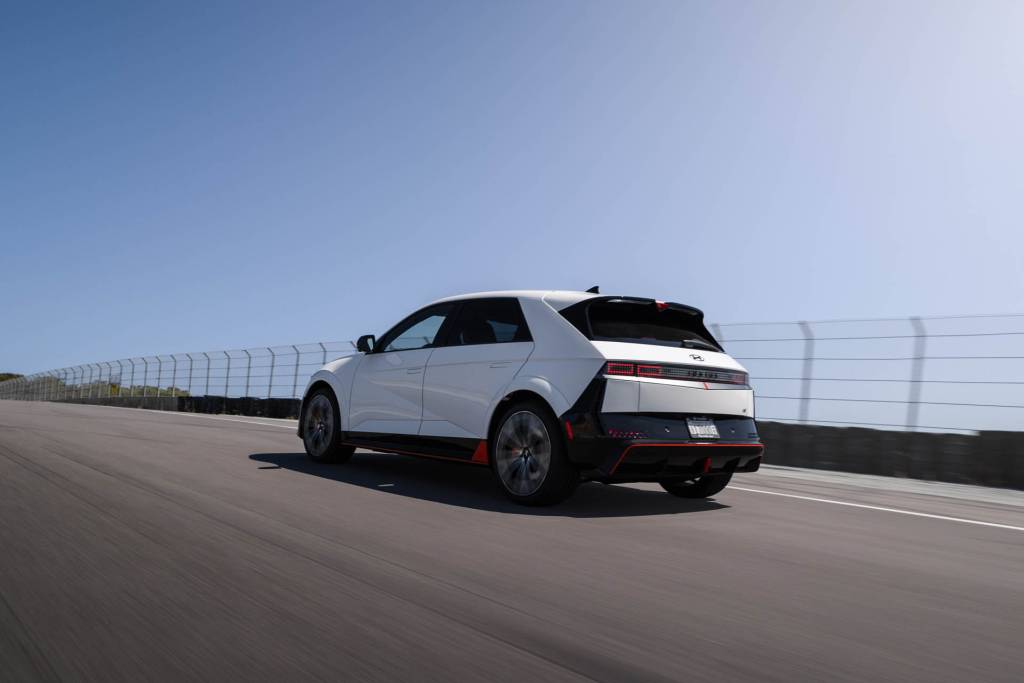
2025 Hyundai Ioniq 5 N
What about the Ioniq 5 N propulsion sounds themselves? What was the inspiration for this “simulated” part of its experience?
Okay, let’s talk about the sound! Hyundai has incorporated what it calls N Active Sound+ into the myriad choices drivers can make in the Ioniq N 5. Of course, you can have no sound, just the slight metallic whirr or the electric motors spinning up. That’s great for everyday driving but track shenanigans call for drivers to use all their senses, aural included.
The best sounding option by far is called Ignition. This is based on the 2.0-liter turbo four-cylinder engine found in the Elantra N, complete with lift-off pops and gurgles. My first session on the track was in silent mode with the single-speed gearbox doing its own thing. When I turned on the N e-Shift and the N Active Sound+, I got the physical motion of snapping off gears with the paddle shifters and the audible cues of a throaty little engine. Suddenly I was much more invested in the experience, and my time shows it. Sure, I’m no Max Verstappen, but my second session went by much quicker than the first, and it was much more fun to boot.
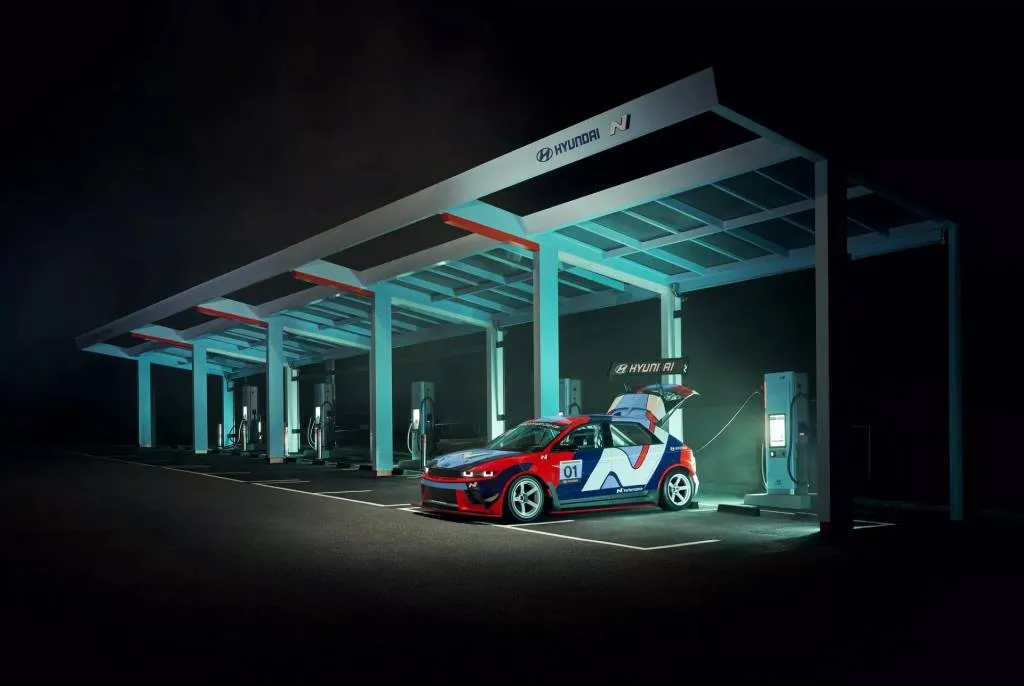
2024 Hyundai Ioniq 5 N eN1 Cup race car
The sound is pumped into the car from eight speakers, but also released to the unsuspecting pedestrian through two external speakers. Park said that those participating in the new eN1 Cup racing series in South Korea with the Ioniq 5 N may one day get to choose their own bespoke sound, so fans know who is coming around that corner and on to the straight.
I think I’d want mine to sound like a Mötley Crue guitar riff, but I digress.
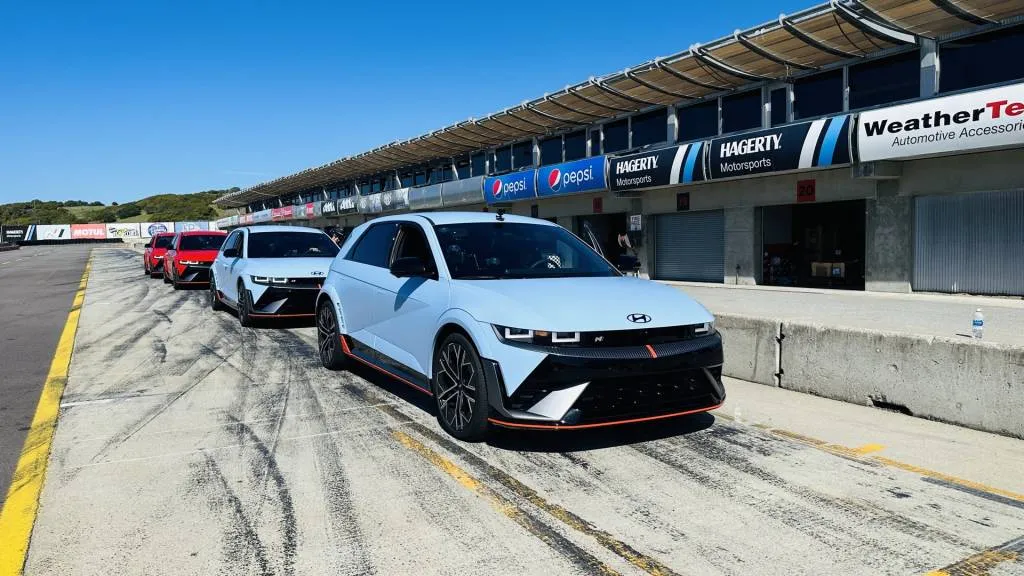
2025 Hyundai Ioniq 5 N – Emme Hall
Preconditioning is as much about getting the most track time as it is getting the quickest charge. How does this all work in the 2025 Hyundai Ioniq 5?
Of course, EVs have a few disadvantages when it comes to running hot and heavy on the track. Sure, an ICE vehicle will likely need more fuel during a day of track driving, but it’s a task completed in five minutes or less. With an EV, there are so many other components that come into play to make sure the batteries can deliver the most power and recharge quickly.
First, there is power delivery. The battery in the Ioniq 5 N can be set for a sprint race with an optimal battery temperature of 86 to 104 degrees Fahrenheit or an endurance race, where the temperature should be a bit cooler, between 68 and 86 degrees or so. Keep in mind that these numbers are for optimal performance, not range. During my time on the track I lost 10% of my charge in each of my two endurance sessions and the battery temperature stayed around 70 degrees. I used 16% of my battery juice in my one sprint session ending with a battery temperature of 93 degrees.
The Ioniq 5 N has triple the amount of cooling surfaces as the regular Ioniq 5, a cooling element inside the battery and its own separate radiator as well. Further, the computer can tell the driver how long it will take to reach optimal temperature, so she knows just how long before the next track session is a go.
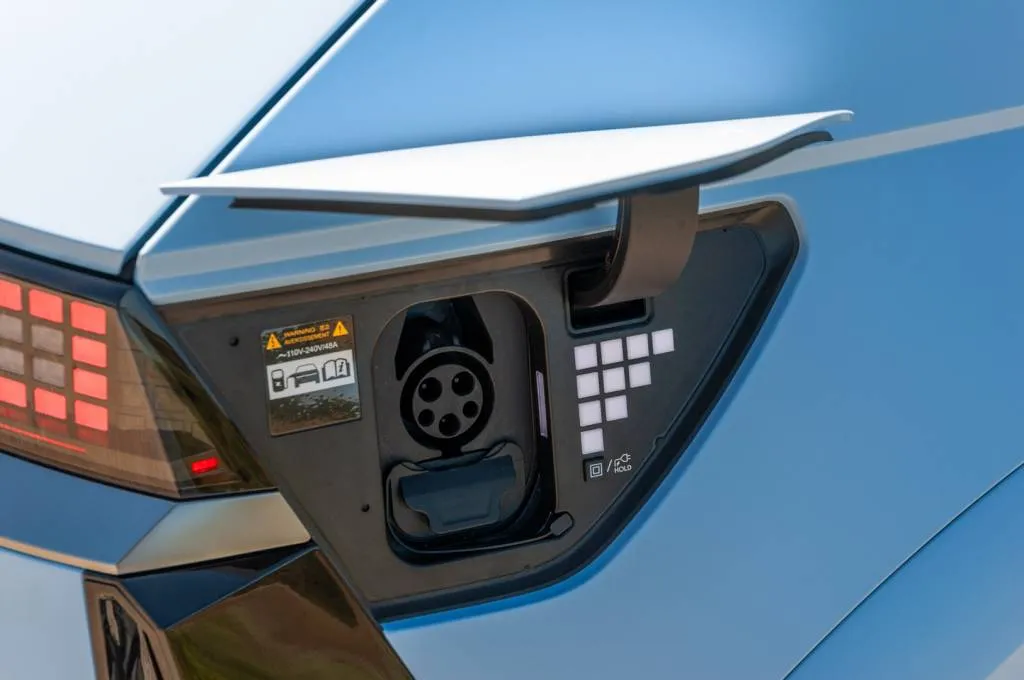
2025 Hyundai Ioniq 5 N
When it comes to charging, the Ioniq 5 N can fast-charge at a peak of about 235 kw thanks to its 800-volt architecture. However, anyone with any experience with an EV knows that rate is not guaranteed. Not only does the charger need to be reliable enough to deliver the power; the battery pack needs to be ready to accept it. Like most EVs, the Ioniq 5 N can condition the batteries for charging, getting temperatures in that sweet charging spot between 68 and 86 degrees.
Hyundai has installed 10 high-speed chargers at the Inje Speedway in South Korea to support its new eN1 Cup racing series. It also hopes to put chargers at tracks around the world including the famous Nurburgring, where the company says the Ioniq 5 N can do two laps flat-out of the nearly 13-mile track in Endurance mode.
As for charging at Laguna Seca, Hyundai had to hire a few trucks with generators to keep the electrons flowing. There are Tesla Superchargers but the Ioniq 5 N does not have NACS capability, nor is the station a Magic Dock station. Nuts.
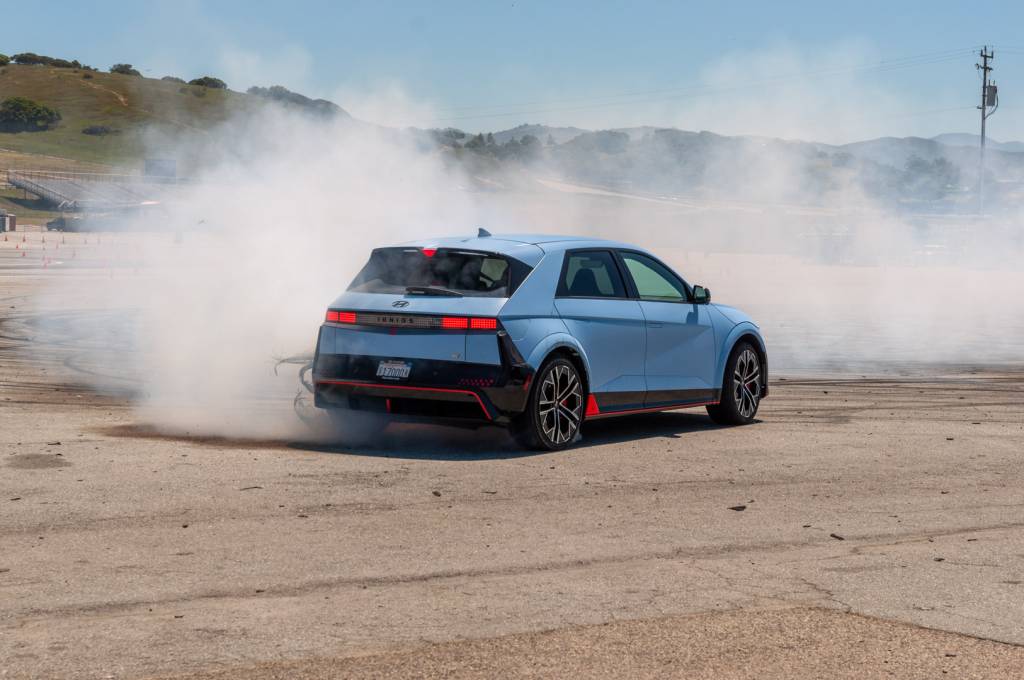
2025 Hyundai Ioniq 5 N
Overall, does the Ioniq 5 N compare to the EV6 GT in driving thrills—and in driving range?
Although the Kia EV6 GT might be built on the same platform as the Ioniq 5 N, the two are hardly comparable. Don’t get me wrong, the EV6 can generate 576 horsepower and 545 pound-feet of torque from its two electric motors—close—and it shares a few features with the Ioniq 5 N like an electronic limited-slip differential and a drift mode, but not its larger battery and intensified pack cooling. At the end of the day the EV6 GT is a quick car that can carve a canyon or two. It’s not a track car.
The EV6 GT doesn’t have an e-Shift feature nor deliver any audible cues, both of which enhance the Ioniq 5 N to the, ehem, nth degree. The Hyundai also has distinct settings for the motors, the steering, the electronic limited-slip differential, suspension and steering feel and the driver can push close to 100-percent of the torque to the rear wheels if he so desires.
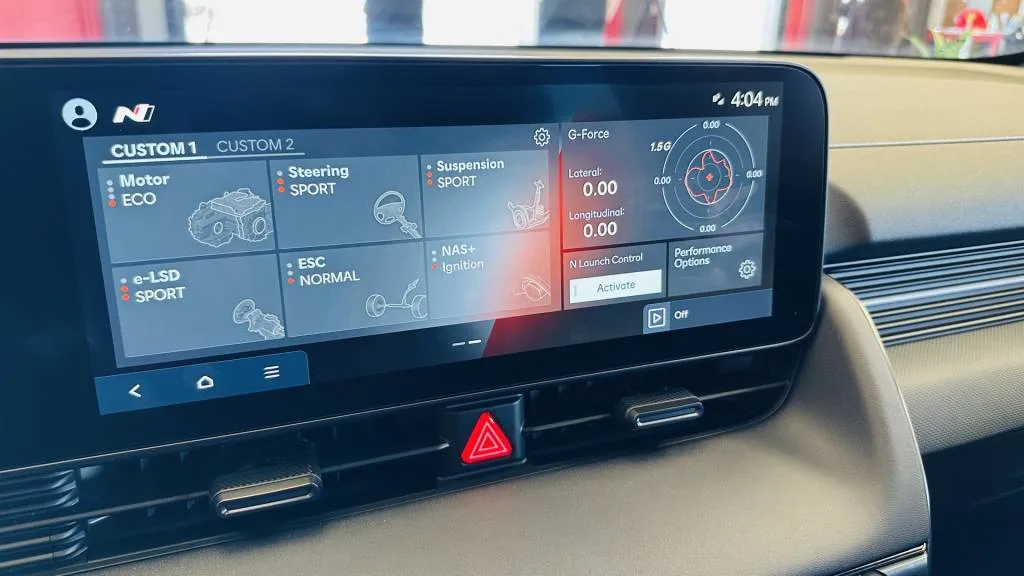
2025 Hyundai Ioniq 5 N – Emme Hall
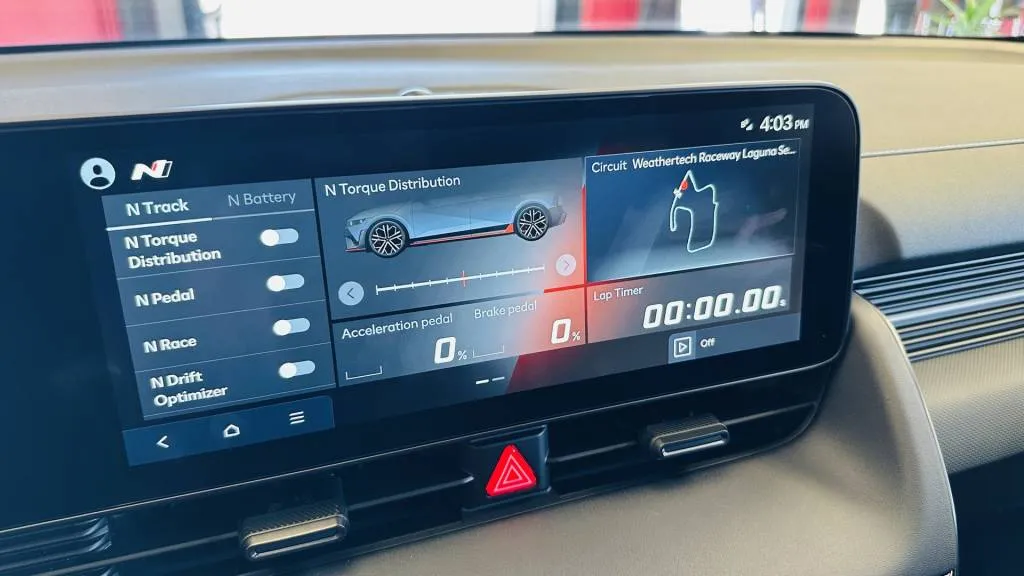
2025 Hyundai Ioniq 5 N – Emme Hall
There are even two different kinds of brake regeneration: I-pedal with your standard levels of regen or N pedal, which is meant more for weight transfer. Select this setting and the 0.36g of regen not only slows the car before a turn, but really gets the weight moved to the front, helping the Pirelli P Zero tires grip through the turns. Yeah, you’ll hear some squealing but trust me, the grip is there. The EV6 GT with its less sticky Goodyear Eagle F1 shoes just can’t compare.
As for driving range, well, that’s a tough one. I got to sample the Ioniq 5 N on public roads, but not for an extended amount of time. Hyundai says the 84-kwh battery is good for 221 miles of range—less, of course, while hooning on a track. Meanwhile the 77.4 kWh battery in the Kia EV6 GT can eke out 206 miles. Again, I would expect it to be difficult to hit that EPA number if you exploit the GT’s power at every green light.
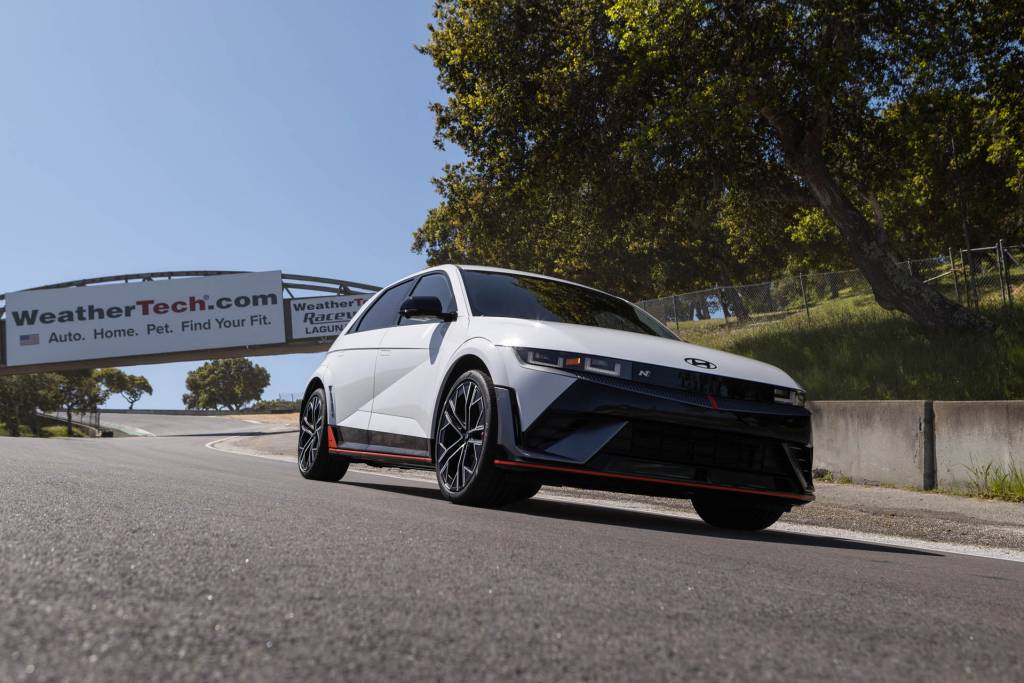
2025 Hyundai Ioniq 5 N
Hyundai Ioniq 5 N summary: Driving joy
By the time I left Laguna Seca I was worn out. I had pushed through the fearsome turn 1 at triple digits, bothered Hyundai engineers with technical questions and loved every second of it. While the 2025 Ioniq 5 N might be a rolling computer with myriad complicated settings, it produced more emotion and amusement than I thought possible from an electric vehicle.
This isn’t a car about saving the world with a green powertrain. It isn’t about making a commute safer with advanced driver’s aids or even about pushing the boundaries of all-electric range. No, the Ioniq 5 N is about driving joy. And I’m here for it.
